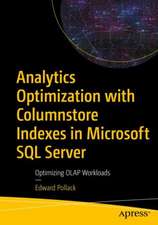Logical Data Modeling: What it is and How to do it: Integrated Series in Information Systems, cartea 5
Autor Alan Chmura, J. Mark Heumannen Limba Engleză Hardback – 29 sep 2004
| Toate formatele și edițiile | Preț | Express |
|---|---|---|
| Paperback (1) | 642.84 lei 6-8 săpt. | |
| Springer – 19 noi 2010 | 642.84 lei 6-8 săpt. | |
| Hardback (1) | 649.93 lei 6-8 săpt. | |
| Springer – 29 sep 2004 | 649.93 lei 6-8 săpt. |
Din seria Integrated Series in Information Systems
- 15%
 Preț: 646.62 lei
Preț: 646.62 lei - 20%
 Preț: 996.07 lei
Preț: 996.07 lei - 20%
 Preț: 1272.94 lei
Preț: 1272.94 lei -
 Preț: 389.11 lei
Preț: 389.11 lei - 20%
 Preț: 998.04 lei
Preț: 998.04 lei - 15%
 Preț: 654.43 lei
Preț: 654.43 lei - 20%
 Preț: 1933.71 lei
Preț: 1933.71 lei -
 Preț: 388.52 lei
Preț: 388.52 lei - 15%
 Preț: 646.11 lei
Preț: 646.11 lei - 15%
 Preț: 667.71 lei
Preț: 667.71 lei - 15%
 Preț: 711.89 lei
Preț: 711.89 lei -
 Preț: 393.52 lei
Preț: 393.52 lei - 15%
 Preț: 644.82 lei
Preț: 644.82 lei - 18%
 Preț: 955.25 lei
Preț: 955.25 lei - 5%
 Preț: 1280.25 lei
Preț: 1280.25 lei - 15%
 Preț: 586.55 lei
Preț: 586.55 lei - 15%
 Preț: 638.11 lei
Preț: 638.11 lei - 20%
 Preț: 1277.24 lei
Preț: 1277.24 lei - 20%
 Preț: 1215.12 lei
Preț: 1215.12 lei - 20%
 Preț: 638.37 lei
Preț: 638.37 lei - 5%
 Preț: 1801.57 lei
Preț: 1801.57 lei - 18%
 Preț: 952.72 lei
Preț: 952.72 lei - 15%
 Preț: 653.14 lei
Preț: 653.14 lei - 20%
 Preț: 995.75 lei
Preț: 995.75 lei - 20%
 Preț: 649.28 lei
Preț: 649.28 lei
Preț: 649.93 lei
Preț vechi: 812.42 lei
-20% Nou
Puncte Express: 975
Preț estimativ în valută:
124.37€ • 128.30$ • 103.78£
124.37€ • 128.30$ • 103.78£
Carte tipărită la comandă
Livrare economică 27 martie-10 aprilie
Preluare comenzi: 021 569.72.76
Specificații
ISBN-13: 9780387229508
ISBN-10: 0387229507
Pagini: 228
Ilustrații: XII, 228 p.
Dimensiuni: 155 x 235 x 20 mm
Greutate: 0.54 kg
Ediția:2005
Editura: Springer
Colecția Springer
Seria Integrated Series in Information Systems
Locul publicării:New York, NY, United States
ISBN-10: 0387229507
Pagini: 228
Ilustrații: XII, 228 p.
Dimensiuni: 155 x 235 x 20 mm
Greutate: 0.54 kg
Ediția:2005
Editura: Springer
Colecția Springer
Seria Integrated Series in Information Systems
Locul publicării:New York, NY, United States
Public țintă
Professional/practitionerCuprins
Getting Started.- The Art Gallery Web: A Data Modeling Example.- Building the Data Map.- The Art Gallery Web (Continued).- Keys and Valid Associations.- The Art Gallery Web (Continued).- Defining Attributes.- The Art Gallery Web (Continued).- Verifying the Data Model.- Validating the Data Model.- Design Patterns.- From Logical to Physical.- The End and the Beginning.
Textul de pe ultima copertă
LOGICAL DATA MODELING: What It Is and How To Do IT is directed toward three groups of people: (1) Business subject matter experts, (2) information technology professionals, (3) advanced students in Computer Science, Management Information Systems, and e-Business. Its purpose is to outline the basics of logical data modeling—specifically, data modeling for relational database management systems—in simple, practical terms and in a business context. The focus on relational data modeling is consciously made because it is superior in modeling real business activities.
By reading and understanding this book, the enterprise-side project managers should gain enough understanding of data modeling to understand the principles and help communicate that understanding to the people who know the business, do the work, and are going to be affected by the system that is being created.
By reading and understanding this book, the enterprise-side project managers should gain enough understanding of data modeling to understand the principles and help communicate that understanding to the people who know the business, do the work, and are going to be affected by the system that is being created.
Caracteristici
Covers the basics of logical data modeling from the beginnings through the normal forms, along with discussions of design patterns, the transition from logical data model to physical database design, and the use of an enterprise modeling tool, Visible Advantage Purpose is to present a clear, simple, direct, explicit, and systematic approach to developing a logical data model, complete with illustrations, examples, exercises, and standard terminology





























